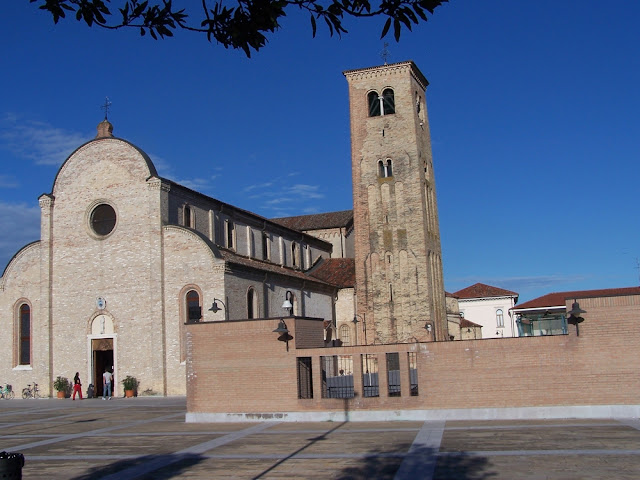It's history illustrates how the rise and ebbs of time change the fortunes of places and their people. Once an important transit point for the Roman empire, today it is a small but charming agricultural town of about ten thousand persons.
If you are staying in one of the seaside holiday towns along the northern Adriatic coast of Italy like Jesolo, Caorle, Bibione and Lignano, you might like to spend a day visiting Portogruaro and Concordia-Sagittaria.
Roman Town of Julia Concordia
The town existed as a small pre-Roman area since 9th century BCE, as confirmed by some archeological finds shown in its museum. Romans gave it the name of Julia Concordia.
The Roman empire had started as the Roman Republic in the city-state of Rome around 150 BCE. Julia Concordia was founded in 42 BCE, during the last years of the Roman Republic (Roman empire period started in 31 BCE). By that time, all of northern Italy was part of the Roman Republic. Foundation of Julia Concordia coincided with the northwards expansion of the Roman empire towards northern and central Europe.
In the second century BCE, the Romans had already built their biggest port in Acquileia, around 300 km north of Julia Concordia. The Annia road connected Acquileia to the town of Padua, south of Venice, while the Postumia road connected Acquileia to the Genova port on the west. Concordia was chosen to be the Roman city because those two key roads crossed here while the Lemene river provided an entrance to the Adriatic coast and to the inland port of Portogruaro. Over the next centuries, Julia Concordia became an important Roman town with the construction of bridges, an amphitheatre and baths.
The local legend says that the Roman legionaire who had shot Jesus Christ while he was on the cross in Jerusalem with his arrow, was from Concordia. Later on St Mark was supposed to have stayed in the house of the same legionaire while he was writing his version of the Gospels. Still later, a chapel was built at that location, which was close to the present location of the St Stephen cathedral.
After the fall of the Roman empire, Concordia was destroyed many times, first by the army of Attila the Hun and then by the Lombards.
During the Roman period, the town of Julia Concordia was known for its arrow-making (Sagitae). Thus, in early 20th century, its name was changed to Concordia-Sagittaria. Probably, it was done during the Mussolini period, when remembering the glorious Roman past was considered as important for the nation-building.
Archaeological Ruins in Concordia
Remains of the Roman times dot the landscape in and around Concordia-Sagittaria. There are ruins of mosaic floors, amphitheatre, ancient baths and tombs of the soldiers. Most archeological finds from Concordia-Sagittaria are kept in the national museum in Portogruaro, some kilometres away. Some of the archeological finds are also shown in the local museum of Concordia-Sagittaria.
Underneath the tenth century cathedral dedicated to St. Stephen near the city centre, you can visit the old ruins with a beautiful mosaic floor (the entrance is inside the cathedral).
The nearby Baptistry (in the image below) made in the form of the Greek cross on a square base, is from 11th century while the bell tower is from 12th century.
I was told that some ruins of an old Roman bridge and the amphitheatre were located in the countryside, just outside Concordia town but I was unable to go and look for them.
Walks in the City Centre
The city has a tiny and quaint centre with its historical municipal building, colourful houses and simple trattorias for a relaxed lunch of local cuisine. The Bishop's house from 1450 CE, built in Venetian style and the Town Hall from 1526 CE are two beautiful buildings, to be visited in the tiny city centre.
Lemene river passes through the city centre of Concordia-Sagittaria. The whole area along the river is wonderful for a leisurely walk or a picnic, while admiring the ducks and geese in the water and the beautiful panoramas.
The city hosts a famous annual local fair dedicated to the city's Patron saint, it is called "la fiera di Santo Stefano" and is held around the end of July each year.
Finally
Italy is full of beautiful historical towns. Most tourists coming to visit Italy hardly ever manage to go beyond Florence, Venice, Pisa and Rome. However, if you are visiting the Adriatic coast in the north-east of Italy for the summer holidays, you can also visit the nearby smaller towns. In that case, it might be worthwhile for you to combine the visits to Portogruaro and Concordia-Sagittaria.
I am not very fond of the seaside holidays, but they are loved by my family. We usally go to Bibione for these holidays. For me the seaside holidays are an opportunity to visit the smaller towns, such as Concordia-Sagittaria and to explore thier histories.
***











